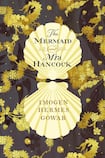
"What trapped creature does not strike out?" Inspired by a "real mermaid" in the British Museum, Imogen Hermes Gowar's debut novel tells a most interesting tale about a merchant and a prostitute in Georgian London whose fates entwine over mythical sea creatures. While the mermaid in the British Museum is composed of the upper part of a monkey's body and a fishtail, the two that appear in The Mermaid and Mrs Hancock are exotic treasures celebrated across the city.
In the autumn of 1785, widowed merchant Jonah Hancock showcases his fossilised mermaid to an enthralled public, earning him fame and fortune as people flock to see it. His prized possession puts him in the path of Mrs Chappell, an entrepreneurial spirit who runs a high-class brothel and wants to use the mermaid as another exoticism to entertain her customers. Having just worked her way out of Mrs Chappell’s service is the delightful heroine Angelica Neal, who is coerced into one final job for her former madam: to beguile Mr Hancock with her womanly wiles into handing over his mermaid.
The parallels between the mermaid of yore and the plucky female characters in The Mermaid and Mrs Hancock are many. Angelica and her co-workers are at once trapped women and wielders of power, trying to live the best life possible in a world ruled by men. Hermes Gowar presents multiple memorable women to highlight her theme: crafty Mrs Chappell; never-say-die Angelica; former prostitute turned feminist Bel Fortescue; mean-spirited Mrs Frost, who survives like a parasite off Angelica's labours; Mr Hancock's world-weary sister Mrs Lippard; and finally, her whipsmart youngest daughter Susie, who is sent to live with her uncle and becomes a driving force behind Mr Hancock and Angelica's union.
Lyrical passages
Woven into the pecuniary worlds of merchant life and prostitution are lyrical passages from the mermaid, who imbues all who meet her, especially men, with a fierce melancholy. In the hands of a lesser writer, so many worlds colliding could result in disaster but at just under 500 pages, the author retains admirable control over all the narrative strands, never letting the pace flag.
This is historical fiction at its finest, combining myth and legend with the brutal realities of the past, chief among them the mistreatment of women and black people and the inequality that existed among the classes. Comparisons will be drawn to the works of contemporary authors Sarah Waters and Michael Faber, particularly Faber's The Crimson Petal and the White, which charts similar terrain, but The Mermaid and Mrs Hancock has more in common with the novels of Dickens and Austen.
There is Dickens’s searing commentary on the working and industrial classes, his vast cast of colourful side characters, brought to life with vivid names and descriptions. Mrs Lippard is “fifty-five, as straight and cool as a steel pin, with ten fine children to exert her will upon the world”. The upper-class men who visit the brothels announce themselves with “the officious cloppeting of their cork-soled shoes on the parquet”. Angelica “sits at her dressing table as cool and fragrant as a rosewater custard”, a posture that belies an immense intellect and “the knowledge that it is better always to be fierce than to be sad”.
The Austen-worthy passive-aggressive dialogue of polite society brings much humour to the book, with exchanges among female characters full of one-upmanship and tension. Austen is also channelled through the omniscient narrator’s acerbic views on society. In a line that plays upon her most famous opening line, we learn of Mr Hancock’s situation as a widower: “A man without the immediate demands of wife and children finds himself called upon for a multitude of little wants elsewhere.”
'Particular pleasure'
But the Austen-like pronouncements in Hermes Gowar’s novel come from a smuttier world where propriety comes second to desire: “Virtuous people will not know that very particular pleasure two strangers feel when, without touching or speaking, they are agreed that they will end the night together.” On more serious topics, the voice is equally engaging and the detail pinpoint clear: “For class is a type of bubble, a membrane around one, and although one might grow within this membrane, and strain against it, it is impossible to break free from it.”
Hermes Gowar studied archaeology, anthropology and art history at the University of East Anglia before going on to work in museums. Writing short fiction inspired by the surrounding artefacts, she won the Malcolm Bradbury Memorial Scholarship to study for an MA in creative writing at UEA. Her dissertation won the Curtis Brown Prize, which subsequently grew into this hugely enjoyable debut novel. Early as it is in the year to be predicting Booker nominations, if debuts feature as prominently as they did on last year's longlist, this will surely merit consideration.
















